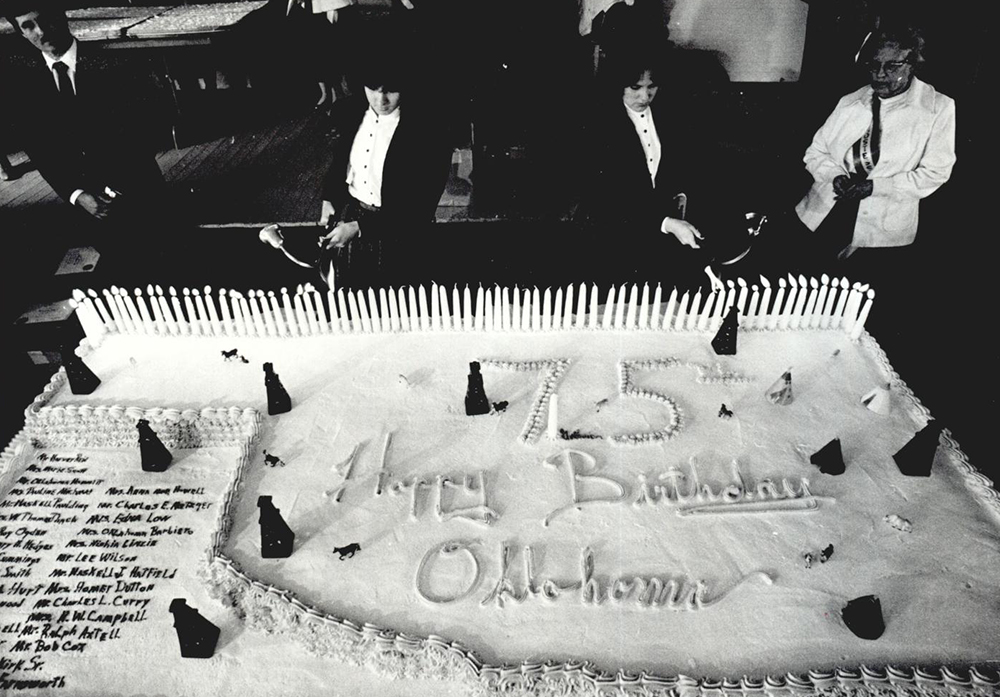
The Encyclopedia of Oklahoma History and Culture
DIAMOND JUBILEE OF STATEHOOD.
Oklahoma commemorated seventy-five years of statehood with events scheduled between June 13, 1981, and November 16, 1982. In December 1980 Gov. George Nigh asked Jack T. Conn, president of the Oklahoma Historical Society, to chair the proposed Diamond Jubilee Commission. Former U.S. House Speaker Carl Albert was made honorary chair. The date June 13, 1981, was chosen because it was the weekend before the seventy-fifth anniversary of the Enabling Act, signed by Pres. Theodore Roosevelt on June 16, 1906, and because there were seventy-five weeks between the two dates. A logo using the official state colors of green and white was designed with the state outline and the number 75 superimposed on it. The official slogan was "You're Doin' Fine, Oklahoma!"
The jubilee started on June 13, 1981, with events occurring simultaneously across the state. The Broadway musical Oklahoma! was performed at the Civic Center Music Hall in Oklahoma City from June 13 through July 14, 1981, with a special Diamond Jubilee performance held on June 13. Tulsans also enjoyed a special performance of Oklahoma! and a barbecue at Tulsa's Discoveryland Outdoor Musicals. A horse race and a music festival starring Waylon Jennings were held at Midway Downs in Stroud on June 13. An air show was scheduled at Haskell on June 13 and 14. California aviator and pilot Calvin Pitts and Joe Cunningham of Tulsa left Wiley Post Airport in Oklahoma City on June 13 to retrace the around-the-world flight that Wiley Post had made fifty years earlier.
Oklahoma was the featured state at the Festival of American Folklife sponsored by the Smithsonian Institution and the National Park Service and held in Washington, D.C., on June 24–28 and July 1–5, 1982. Based on their talents in the area of crafts, music, horsemanship, and service in the petroleum industry, ninety Oklahomans were selected to represent the state. The folklife programs were repeated at the State Fair in Oklahoma City on September 24–28, 1982, and at the Tulsa State Fair on October 1–5, 1982.
Some of the 1,466 approved Diamond Jubilee projects included bronze sculptures of the twenty-one Oklahoma governors by sculptor Leonard D. McMurray, a Diamond Jubilee marker on the State Capitol grounds, a Diamond Jubilee state quilt, and a music record album, entitled Oklahoma Country, by Oklahoma artists. Like the 1957 Semicentennial of Statehood, Oklahomans held art exhibits, western days, rodeos, parades, festivals, and powwows. Public and school libraries sponsored reading programs. Projects also included the publication of county and regional histories, cookbooks with pioneer recipes, and oral histories. The state legislature approved funding for preservation and restoration of state-owned historic sites and museums. The Oklahoma City Regional Fashion Group worked on a project to collect and display the former Oklahoma First Ladies' inaugural gowns.
Newspapers published special articles relating the state's history. The Oklahoma Today magazine's Diamond Jubilee edition, published in spring 1982, featured articles on Oklahoma's diversity, heritage, and scenery. A limited special edition of the Directory of Oklahoma, ordinarily printed every odd-numbered year, was published in 1982. Souvenirs included belt buckles, jewelry, mugs, and commemorative Frankhoma pottery. A bronze medallion, designed by Carolyn Gregg Hill, featured oil, wheat, and cattle, representing the state's major economic bases.
The Diamond Jubilee Arts Festival, held at the State Capitol on September 17–19, 1982, spotlighted Oklahoma artists, sculptors, authors, musicians, dancers, and dramatists. On November 13, 1982, the Diamond Jubilee Show, featuring famous Oklahomans, was held at the Oklahoma City Myriad Convention Center. Among the celebrities were television personalities James Garner, Rue McClanahan, Ben Johnson, and Candice Earley, and music artists Patti Page, Claude Williams, Barney Kessel, and Jimmy Webb.
Diamond Jubilee events culminated on Statehood Day, November 16, 1982. In Guthrie, the original capital city, a mock wedding ceremony joined Oklahoma and Indian territories. A parade and a barbecue followed. Participants received nine ounces of barbecued beef, a slice of white bread, a pickle, and coffee, the same items served at the 1907 barbecue. A formal dinner and ball were held that evening at the local Scottish Rite Temple. Across the state, school children released balloons at 10:30 a.m. to coincide with activities in Guthrie. Attached to each balloon was a card that gave the child's name and address. Many students received responses from individuals who found the balloons as far away as England, Germany, Canada, and the Bahamas. Children also wore western clothing, played early-day games, and sang songs from the turn of the twentieth century.






